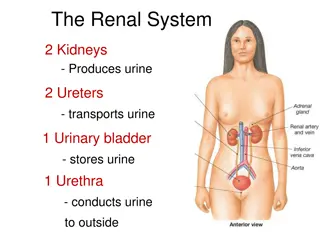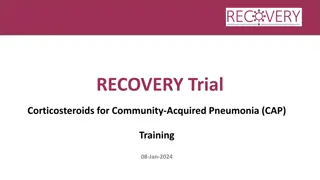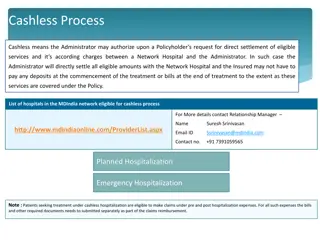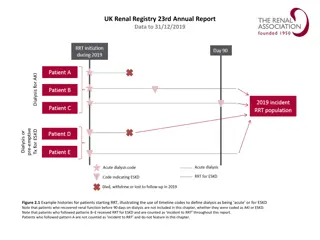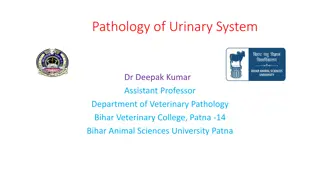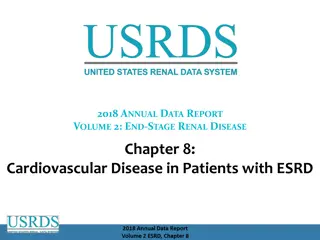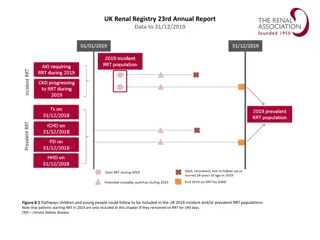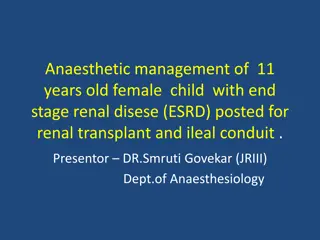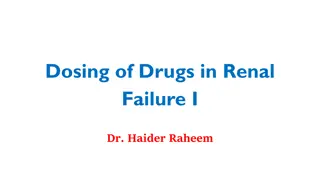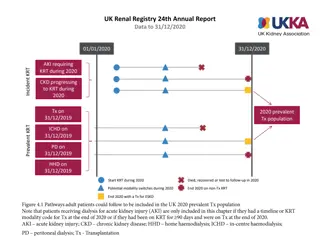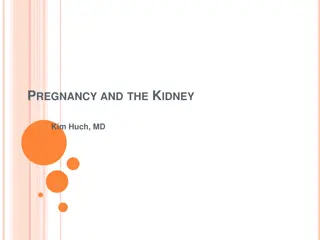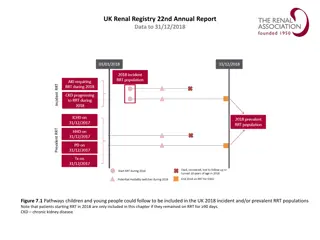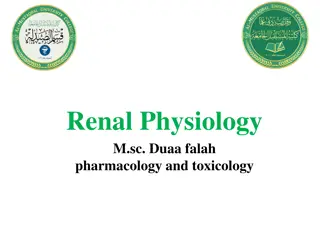Hospitalization Trends for End-Stage Renal Disease Patients 2006-2015
Analysis of adjusted hospitalization rates for End-Stage Renal Disease (ESRD) patients by treatment modality from 2006 to 2015, indicating differences in rates based on age, sex, race, and primary cause of kidney failure. The data covers all-cause and cause-specific hospitalization rates for ESRD patients undergoing peritoneal dialysis and transplant. Insights into prevalent ESRD patients and their interactions are derived from the USRDS ESRD Database, with a standard population reference of ESRD patients in 2011.
Download Presentation

Please find below an Image/Link to download the presentation.
The content on the website is provided AS IS for your information and personal use only. It may not be sold, licensed, or shared on other websites without obtaining consent from the author. Download presentation by click this link. If you encounter any issues during the download, it is possible that the publisher has removed the file from their server.
E N D
Presentation Transcript
2017 ANNUAL DATA REPORT VOLUME 2: END-STAGE RENAL DISEASE Chapter 4: Hospitalization 2017 Annual Data Report Volume 2 ESRD, Chapter 4
vol 2 Figure 4.1 Adjusted hospitalization rates for ESRD patients, by treatment modality, 2006-2015 Data Source: Reference Tables G.1, G.3, G.4, G.5, G.6, G.8, G.9, G.10, and special analyses, USRDS ESRD Database. Period prevalent ESRD patients; adjusted for age, sex, race, primary cause of kidney failure, & their two-way interactions; standard population: ESRD patients, 2011. Abbreviation: ESRD, end-stage renal disease. 2017 Annual Data Report Volume 2 ESRD, Chapter 4 2
vol 2 Figure 4.2 Adjusted all-cause & cause-specific hospitalization rates for ESRD patients, by treatment modality, 2006-2015 Data Source: Reference Tables G.1, G.3, G.4, G.5, and special analyses, USRDS ESRD Database. Period prevalent ESRD patients; adjusted for age, sex, race, primary cause of kidney failure, & their two-way interactions; standard population: ESRD patients, 2011. Abbreviation: ESRD, end-stage renal disease. 2017 Annual Data Report Volume 2 ESRD, Chapter 4 3
vol 2 Figure 4.2 Adjusted all-cause & cause-specific hospitalization rates for ESRD patients, by treatment modality, 2006-2015 Data Source: Reference Tables G.1, G.3, G.4, G.5, and special analyses, USRDS ESRD Database. Period prevalent ESRD patients; adjusted for age, sex, race, primary cause of kidney failure, & their two-way interactions; standard population: ESRD patients, 2011. Abbreviation: ESRD, end-stage renal disease. 2017 Annual Data Report Volume 2 ESRD, Chapter 4 4
vol 2 Figure 4.2 Adjusted all-cause & cause-specific hospitalization rates for ESRD patients, by treatment modality, 2006-2015 (c) Peritoneal dialysis Data Source: Reference Tables G.1, G.3, G.4, G.5, and special analyses, USRDS ESRD Database. Period prevalent ESRD patients; adjusted for age, sex, race, primary cause of kidney failure, & their two-way interactions; standard population: ESRD patients, 2011. Abbreviation: ESRD, end-stage renal disease. 2017 Annual Data Report Volume 2 ESRD, Chapter 4 5
vol 2 Figure 4.2 Adjusted all-cause & cause-specific hospitalization rates for ESRD patients, by treatment modality, 2006-2015 (d) Transplant Data Source: Reference Tables G.1, G.3, G.4, G.5, and special analyses, USRDS ESRD Database. Period prevalent ESRD patients; adjusted for age, sex, race, primary cause of kidney failure, & their two-way interactions; standard population: ESRD patients, 2011. Abbreviation: ESRD, end-stage renal disease. 2017 Annual Data Report Volume 2 ESRD, Chapter 4 6
vol 2 Table 4.1 Adjusted rates of all-cause & cause-specific hospitalization per patient year for adult hemodialysis patients, 2006-2015 All Cardiovascular Any infection 2006-2007 2.04 0.59 0.48 2008-2009 2.01 0.57 0.49 2010-2011 1.97 0.54 0.49 2012-2013 1.80 0.49 0.45 2014-2015 1.73 0.46 0.44 2014-2015, by patient characteristics Age 22-44 1.93 0.44 0.45 45-64 1.69 0.44 0.42 65-74 1.74 0.48 0.45 75+ 1.79 0.49 0.49 Sex Male 1.58 0.43 0.41 Female 1.92 0.50 0.48 Race White 1.76 0.45 0.47 Black/African American 1.76 0.48 0.41 American Indian or Alaska Native Asian 1.22 0.34 0.33 Native Hawaiian or Pacific Islander Other or Multiracial 1.60 0.44 0.46 Ethnicity Hispanic 1.57 0.42 0.41 Non-Hispanic 1.76 0.47 0.45 Non-Hispanic White 1.86 0.48 0.50 Non-Hispanic Black/African American Cause of Renal Failure Diabetes 1.96 0.50 0.50 Hypertension 1.60 0.46 0.38 Glomerulonephritis 1.47 0.39 0.38 Other Cause 1.70 0.40 0.47 Vintage <1 year 1.79 0.47 0.49 1-<2 years 1.70 0.45 0.43 2-<5 years 1.71 0.47 0.42 5+ years 1.75 0.45 0.45 Vascular access infection 0.25 0.22 0.19 0.13 0.12 0.15 0.12 0.11 0.11 0.10 0.14 0.11 0.14 1.54 0.33 0.49 0.09 0.10 1.19 0.34 0.34 0.08 0.10 0.11 0.12 0.11 1.74 0.48 0.41 0.13 Data Source: Reference Tables G.3, G.13, and special analyses, USRDS ESRD Database. Period prevalent hemodialysis patients aged 22 & older; adjusted for age, sex, race, ethnicity, primary cause of kidney failure, & their two-way interactions. Rates by one factor adjusted for the remaining three; standard population, hemodialysis patients, 2011. See Vol. 2, ESRD Analytical Methods for principal ICD-9-CM diagnosis codes included in each cause of hospitalization category. 0.13 0.11 0.11 0.12 0.13 0.10 0.10 0.14 2017 Annual Data Report Volume 2 ESRD, Chapter 4 7
vol 2 Figure 4.3 Adjusted all-cause hospitalization rates by treatment modality and number of years after start of dialysis, for cohorts of incident patients in 2004, 2007, 2010, and 2013 (a) Hemodialysis patients Data Source: Special analyses, USRDS ESRD Database. Period prevalent ESRD patients, adjusted for age, sex, race, ethnicity, primary cause of kidney failure; standard population: ESRD patients, 2011. 2017 Annual Data Report Volume 2 ESRD, Chapter 4 8
vol 2 Figure 4.3 Adjusted all-cause hospitalization rates by treatment modality and number of years after start of dialysis, for cohorts of incident patients in 2004, 2007, 2010, and 2013 (b) Peritoneal dialysispatients Data Source: Special analyses, USRDS ESRD Database. Period prevalent ESRD patients, adjusted for age, sex, race, ethnicity, primary cause of kidney failure; standard population: ESRD patients, 2011. 2017 Annual Data Report Volume 2 ESRD, Chapter 4 9
vol 2 Figure 4.4 Map of the hospitalization rates of ESRD, by Health Service Area, in the U.S. population, 2014-2015 (a) Unadjusted Data Source: Reference Tables G.1, G.3, G.4, G.5, and special analyses, USRDS ESRD Database. Period prevalent ESRD patients; adjusted for age, sex, race, & primary cause of kidney failure; standard population: ESRD patients, 2011. Values for HSAs with 10 or fewer patients are suppressed. Abbreviation: ESRD, end-stage renal disease. 2017 Annual Data Report Volume 2 ESRD, Chapter 4 10
vol 2 Figure 4.4 Map of the hospitalization rates of ESRD, by Health Service Area, in the U.S. population, 2014-2015 (b) Adjusted Data Source: Reference Tables G.1, G.3, G.4, G.5, and special analyses, USRDS ESRD Database. Period prevalent ESRD patients; adjusted for age, sex, race, & primary cause of kidney failure; standard population: ESRD patients, 2011. Values for HSAs with 10 or fewer patients are suppressed. Abbreviation: ESRD, end-stage renal disease. 2017 Annual Data Report Volume 2 ESRD, Chapter 4 11
vol 2 Figure 4.5 Adjusted hospital days for ESRD patients, by treatment modality, 2006-2015 Data Source: Reference Tables G.1, G.3, G.4, G.5, G.6, G.8, G.9, G.10, and special analyses, USRDS ESRD Database. Period prevalent ESRD patients; adjusted for age, sex, race, primary cause of kidney failure, & their two-way interactions. standard population: ESRD patients, 2011. Abbreviation: ESRD, end-stage renal disease. 2017 Annual Data Report Volume 2 ESRD, Chapter 4 12
vol 2 Figure 4.6 Adjusted hospital days for infection & cardiovascular causes, for ESRD patients by their treatment modality, 2006-2015 (a) Infection Data Source: Special analyses, USRDS ESRD Database. Period prevalent hemodialysis patients, all ages, 2015; adjusted for age, sex, race, primary cause of kidney failure, & their two-way interactions. Includes live hospital discharges from January 1 to December 1, 2015. Cause-specific hospitalizations are defined by principal ICD-9-CM codes. See Vol. 2, ESRD Analytical Methods for principal ICD-9-CM diagnosis codes included in each cause of hospitalization category. Abbreviation: ESRD, end-stage renal disease. 2017 Annual Data Report Volume 2 ESRD, Chapter 4 13
vol 2 Figure 4.6 Adjusted hospital days for infection & cardiovascular causes, for ESRD patients by their treatment modality, 2006-2015 (b) Cardiovascular Data Source: Special analyses, USRDS ESRD Database. Period prevalent hemodialysis patients, all ages, 2015; adjusted for age, sex, race, primary cause of kidney failure, & their two-way interactions. Includes live hospital discharges from January 1 to December 1, 2015. Cause-specific hospitalizations are defined by principal ICD-9-CM codes. See Vol. 2, ESRD Analytical Methods for principal ICD-9-CM diagnosis codes included in each cause of hospitalization category. Abbreviation: ESRD, end-stage renal disease. 2017 Annual Data Report Volume 2 ESRD, Chapter 4 14
vol 2 Figure 4.7 Proportion of patients aged 66 & older discharged alive from the hospital who were either rehospitalized or died within 30 days of discharge, by kidney disease status, 2015 Data Source: Special analyses, USRDS ESRD Database and Medicare 5% sample. January 1, 2015 point prevalent Medicare patients aged 66 & older on December 31, 2013. For general Medicare: January 1, 2015 point prevalent, Medicare patients aged 66 & older, discharged alive from an all-cause index hospitalization between January 1, 2015, and December 1, 2014, unadjusted. CKD determined using claims for 2014. Abbreviations: CKD, chronic kidney disease; ESRD, end-stage renal disease; rehosp, rehospitalization. 2017 Annual Data Report Volume 2 ESRD, Chapter 4 15
vol 2 Figure 4.8 Proportion of hemodialysis patients discharged alive from the hospital who either were rehospitalized or died within 30 days of discharge, by demographic characteristics, 2015 Data Source: Special analyses, USRDS ESRD Database. Period prevalent hemodialysis patients, all ages, 2015, unadjusted. Patients less than age 22 are not represented as a group due to insufficient sample size. Includes live hospital discharges from January 1 to December 1, 2015. Cause-specific hospitalizations are defined by principal ICD-9-CM codes. See Vol. 2, ESRD Analytical Methods for principal ICD-9-CM diagnosis codes included in each cause of hospitalization category. Af Am, African American; AI, American Indian; AN, Alaska Native; NH, Native Hawaiian; NH Black/Af Am, Non-Hispanic Black/African American; NH White, Non- Hispanic White; Other, other, multiracial, or unidentified race; PI, Pacific Islander; rehosp, rehospitalization. 2017 Annual Data Report Volume 2 ESRD, Chapter 4 16
vol 2 Figure 4.8 Proportion of hemodialysis patients discharged alive from the hospital who either were rehospitalized or died within 30 days of discharge, by demographic characteristics, 2015 Data Source: Special analyses, USRDS ESRD Database. Period prevalent hemodialysis patients, all ages, 2015, unadjusted. Patients less than age 22 are not represented as a group due to insufficient sample size. Includes live hospital discharges from January 1 to December 1, 2015. Cause-specific hospitalizations are defined by principal ICD-9-CM codes. See Vol. 2, ESRD Analytical Methods for principal ICD-9-CM diagnosis codes included in each cause of hospitalization category. Af Am, African American; AI, American Indian; AN, Alaska Native; NH, Native Hawaiian; NH Black/Af Am, Non-Hispanic Black/African American; NH White, Non-Hispanic White; Other, other, multiracial, or unidentified race; PI, Pacific Islander; rehosp, rehospitalization. 2017 Annual Data Report Volume 2 ESRD, Chapter 4 17
vol 2 Figure 4.9 Proportion of hemodialysis patients discharged alive that either were rehospitalized or died within 30 days of discharge, by cause of index hospitalization, 2015 Data Source: Special analyses, USRDS ESRD Database. Period prevalent hemodialysis patients, all ages, 2015, unadjusted. Includes live hospital discharges from January 1 to December 1, 2015. Cause-specific hospitalizations are defined by principal ICD-9-CM codes. See Vol. 2, ESRD Analytical Methods for principal ICD-9-CM diagnosis codes included in each cause of hospitalization category. Abbreviations: CVD, cardiovascular disease; rehosp, rehospitalization; VA, vascular access. 2017 Annual Data Report Volume 2 ESRD, Chapter 4 18
vol 2 Figure 4.10 Proportion of hemodialysis patients with cause-specific rehospitalizations within 30 days of discharge, by cause of index hospitalization, 2015 Data Source: Special analyses, USRDS ESRD Database. Period prevalent hemodialysis patients, all ages, 2015, unadjusted. Includes live hospital discharges from January 1 to December 1, 2015. Cause-specific hospitalizations are defined by principal ICD-9-CM codes. See Vol. 2, ESRD Analytical Methods for principal ICD-9-CM diagnosis codes included in each cause of hospitalization category. Abbreviations: CVD, cardiovascular disease; VA, vascular access. 2017 Annual Data Report Volume 2 ESRD, Chapter 4 19
vol 2 Figure 4.11 Proportion of hemodialysis patients discharged alive who were either rehospitalized or died within 30 days of discharge for cardiovascular index hospitalization, by age, 2015 Data Source: Special analyses, USRDS ESRD Database. Period prevalent hemodialysis patients, all ages, 2015, unadjusted. Patients less than age 22 are not represented as a group due to insufficient sample size. Includes live hospital discharges from January 1 to December 1, 2015. Cause-specific hospitalizations are defined by principal ICD-9-CM codes. See Vol. 2, ESRD Analytical Methods for principal ICD-9- CM diagnosis codes included in each cause of hospitalization category. Abbreviation: rehosp, rehospitalization. 2017 Annual Data Report Volume 2 ESRD, Chapter 4 20
vol 2 Figure 4.12 Proportion of hemodialysis patients discharged alive who were either rehospitalized or died within 30 days of discharge for cardiovascular index hospitalization, by cause-specific cardiovascular index hospitalization, 2015 Data Source: Special analyses, USRDS ESRD Database. Period prevalent hemodialysis patients, all ages, 2015, unadjusted. Includes live hospital discharges from January 1 to December 1, 2015. Cause-specific hospitalizations are defined by principal ICD-9-CM codes. See Vol. 2, ESRD Analytical Methods for principal ICD-9-CM diagnosis codes included in each cause of hospitalization category. Abbreviations: AMI, acute myocardial infarction; HF, heart failure; rehosp, rehospitalization. 2017 Annual Data Report Volume 2 ESRD, Chapter 4 21



